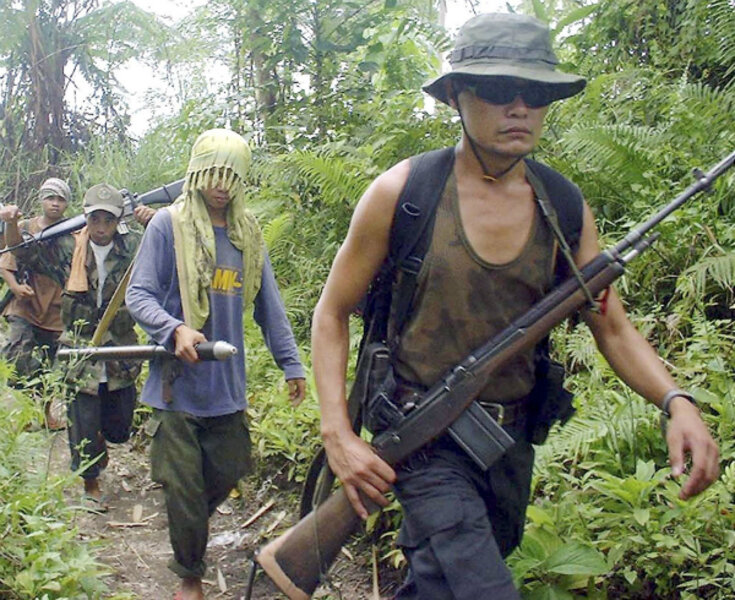Why peace has a foothold in the Philippines
Loading...
| Davao City, Philippines
I’ve recently returned from six months in the Philippines, where another milestone has been passed in peace talks between the government and an armed rebel group, the Moro Islamic Liberation Front (MILF). The milestones are starting to add up, and the destination of peace is finally – after decades of war – coming into view, offering hope to Filipinos and, perhaps, other conflict zones in the world.
The Philippine conflict is centered in Mindanao, the southern island, where the MILF and the government have battled each other year after year. Clan warfare plays a role, and so, too, does a sense of injustice among the island's Muslims toward the country's dominant Christian population.
Perhaps the war’s most devastating mark has been the culture of fear that pervades this Pacific archipelago of 92 million people. Those in the north tend to lump all of Mindanao into one large, terrifying hotbed of armed conflict. The fear also pervades Mindanao – including places that are relatively removed from violent clashes. At any moment, violence could erupt, a bomb could go off, and a place called home could be engulfed in flame.
In April, however, the Philippines government and MILF took a giant step toward peace, agreeing on ways to create an autonomous political entity in the southern region of Mindanao. The agreement demonstrates the earnestness of the two parties to come to a negotiated settlement. A radical fringe group has tried to thwart the peace efforts, but has not succeeded.
In my work as a conflict-resolution specialist on Mindanao, I also met dozens of local “peace practitioners” whose commitment is crucial to a successful outcome of the peace process. Many of them are directly affected by the war. They willingly enter the most violent areas, providing relief in the midst and aftermath of violent clashes, help in healing trauma, temporary shelter for displaced people, and grassroots training in nonviolence. Theirs is a holistic approach to creating a culture of peace in Mindanao – from elementary schools to politicians.
The commitment is paying off. A recent report found that a cease-fire is holding. In the first six months of this year, there were zero armed clashes between the MILF and the Philippines government.
“I can see a small light flickering at the end of the tunnel – it is not a light I have seen before,” said Mohagher Iqbal in May. Mr. Iqbal is the chairman of the MILF peace panel. His statement is remarkable, considering he has been part of the peace negotiations for 15 years.
What makes the potential for sustainable peace a real possibility in the Philippines are the steps being made simultaneously by high-level leaders and grass-roots organizations. Three specific examples come to mind:
1. In March, the Moro (primarily Muslim) tribes of Mindanao gathered together with indigenous tribes to celebrate their shared ancestry. During the “reaffirmation of kinship ceremony,” 31 tribes, many of which have spent the last decade fighting each another, acknowledged their shared lineage and committed themselves to respect and protect each another.
“This event confirms the support of the individual tribes for the peace process and is a key factor in stabilizing the region. Without stability, peace cannot move forward,” said Walee Roslie, a member of the International Monitoring Team in Mindanao.
2. In June, two families who were known for their clan warfare in the Basilan Province – an area particularly susceptible to violence – signed a peace covenant. One of the most cited forms of violence in Mindanao is clan warfare, or rido, I was told by ceasefire monitors.
The peace covenant between the Hataman family and the Akbar family goes well beyond the borders of Basilan. “Forget about pride. If you want to have real peace and unity, you must learn to swallow your pride for your children, for your people,” said Mujiv Hataman at the peace signing, encouraging clans throughout Mindanao to follow a similar path toward reconciliation.
3. In July, the Bangsamoro General Assembly in central Mindanao – the heart of MILF country – brought together 200,000 participants who listened to their leaders about the ongoing peace process. Perhaps most notable were two representatives from the Moro National Liberation Front (MNLF), who, until recently, have had a strained relationship with the MILF. In an unprecedented show of unity, the MILF and MNLF leaders expressed their desire to create a joint forum in an effort to strengthen the peace process in Mindanao.
Each of these events is not enough to suggest that lasting peace in the Philippines is an imminent possibility. But combined, they certainly point toward a bright future for the Philippines.
Of course, much is still needed for a signed peace agreement. The next round of peace talks, scheduled for the end of this month, will continue to identify ways to implement agreed-on principles – from strengthening the sharia judicial system to upholding basic human rights, including the right of women to meaningful political participation.
The road to peace is long, sometimes washed out by drenching rains. But as my peace activist colleague, Dedette Suacito, said to me, “Next time, come with your five children to Basilan. I will show them the beauty of our island. I will show them our beaches and ocean. I will teach them how to dance in the rain.”
I have no children, but I am certainly learning how to dance in the rain.
Angela Lederach is a research associate for the Center for Public Policy Studies and holds a degree in International Peace Studies from the University of Notre Dame. She has recently returned from a 6 month internship in Mindanao, Philippines. To read more about her time in the Philippines you can visit her blog.







